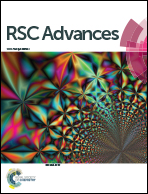New ampholytic microgels based on N-isopropylacrylamide and α-amino acid: changes in swelling behavior as a function of temperature, pH and divalent cation concentration
Abstract
Several new microgels based on N-isopropylacrylamide and the amino acid L-ornithine were synthesized by means of surfactant free emulsion polymerization. N-δ-Acryloyl ornithine was copolymerized with N-isopropylacrylamide and N,N′-methylenebisacrylamide, leading to the synthesis of a new ampholytic microgel. The swelling behavior of the obtained microgels with respect to the amount of amino acid incorporated in the polymer network, temperature, concentration of ions and pH was investigated. The pH dependence of the microgel size, measured at a constant temperature, was found to exhibit a minimum; the pH range where the minimum appeared corresponded well with the pH range where zwitterions dominated. The temperature dependence of the swelling process obtained for different pH values showed that for the pH region where zwitterions dominated, the polymer networks collapsed more efficiently. The presence of free α-amino acid groups attached to the polymeric network of the microgels also enabled the complexation of some metal cations. The influence of the presence of two metal ions (Cu2+ and Ca2+), which differ significantly in their ability to form complexes with the α-amino-acid, on the swelling behavior was investigated. It was found that the presence of copper ions that form stable complexes with the α-amino acid strongly influenced the swelling behavior of the investigated microgels.


 Please wait while we load your content...
Please wait while we load your content...